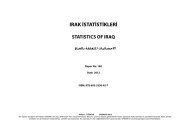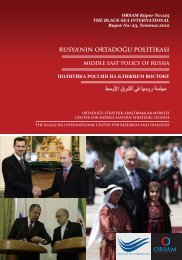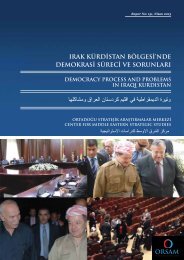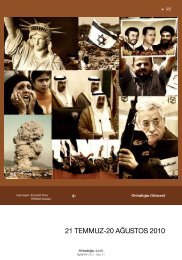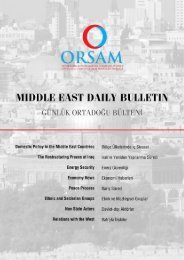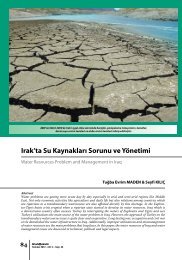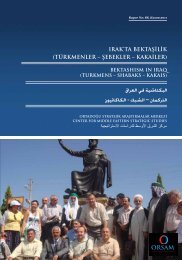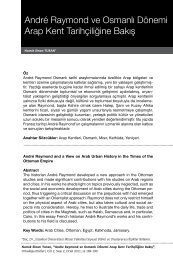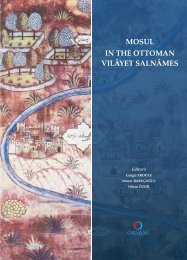turkmen in iraq and their flight - orsam
turkmen in iraq and their flight - orsam
turkmen in iraq and their flight - orsam
Create successful ePaper yourself
Turn your PDF publications into a flip-book with our unique Google optimized e-Paper software.
TURKMEN IN IRAQ AND THEIR FLIGHT: A DEMOCRAPHIC QUESTION<br />
Europe as people were escap<strong>in</strong>g former Yugoslavia<br />
due to the violence follow<strong>in</strong>g the collapse<br />
of the Federal Yugoslavia. The <strong>in</strong>vasion of Iraq<br />
<strong>in</strong> 2003 <strong>and</strong> ongo<strong>in</strong>g military operations s<strong>in</strong>ce<br />
the first Gulf War have provided another unfortunate<br />
example to show us how conflicts are<br />
determ<strong>in</strong><strong>in</strong>g population movements <strong>in</strong> certa<strong>in</strong><br />
regions of the world.<br />
M<strong>in</strong>ority populations are particularly affected<br />
by such conflict situations but one concept is<br />
crucial <strong>in</strong> underst<strong>and</strong><strong>in</strong>g such human mobility:<br />
concept of relative deprivation 26 . Gurr argues<br />
that violent conflicts are more likely to occur<br />
when the gap between people’s expectations<br />
<strong>and</strong> actual situation widens. 27 7 years after the<br />
<strong>in</strong>vasion, we can clearly see that so little improvement<br />
is achieved <strong>in</strong> Iraq <strong>and</strong> <strong>in</strong>ternally displaced<br />
people <strong>and</strong> <strong>their</strong> return <strong>in</strong> Iraq has grown<br />
to be a major problem particularly <strong>in</strong> Kirkuk<br />
area. Thus one can expect <strong>in</strong>tensification of the<br />
potential for civil conflict <strong>in</strong> the country. Such<br />
<strong>in</strong>crease <strong>in</strong> conflict is I believe go<strong>in</strong>g to trigger<br />
more migrations <strong>in</strong>ternally as well as <strong>in</strong>ternationally.<br />
In the follow<strong>in</strong>g sections I will elaborate<br />
the concept of the environment of human <strong>in</strong>security<br />
which I developed for underst<strong>and</strong><strong>in</strong>g<br />
<strong>in</strong>ternational migration <strong>in</strong> conflict situations. I<br />
will also briefly <strong>in</strong>troduce the concept of opportunity<br />
frameworks.<br />
There is a grow<strong>in</strong>g research <strong>in</strong>terest <strong>in</strong> the nexus<br />
of conflict <strong>and</strong> migration. Wars <strong>and</strong> other<br />
latent, less <strong>in</strong>tensive conflicts are closely l<strong>in</strong>ked<br />
to the <strong>in</strong>ternational migration of disadvantaged<br />
ethnic groups 28 ; however, more importantly,<br />
the research shows that <strong>in</strong>tra-state conflicts,<br />
when compared to <strong>in</strong>ter-state conflicts, cause<br />
greater casualties 29 <strong>and</strong>, by implication, cause<br />
larger population displacements. Therefore,<br />
<strong>in</strong>tra-state conflicts deserve more attention<br />
from migration researchers. Nonetheless, as a<br />
force which facilitates <strong>in</strong>ternational migration,<br />
“conflict” is not limited to extremely violent<br />
struggles but <strong>in</strong>cludes a range of situations <strong>in</strong><br />
which parties with conflict<strong>in</strong>g <strong>in</strong>terests meet.<br />
Contemporary <strong>in</strong>ternational migration is better<br />
understood as a complicated human movement,<br />
<strong>in</strong>volv<strong>in</strong>g different types of migrants,<br />
such as ‘refugees’, ‘asylum seekers’, ‘family migrants’,<br />
‘illegal migrants’, ‘migrant workers’, <strong>and</strong><br />
‘professionals’. In most cases it is impossible to<br />
dist<strong>in</strong>guish ‘economic’, ‘political’ or ‘cultural’<br />
reasons from each other, <strong>and</strong> that people often<br />
move with mixed, <strong>and</strong> overlapp<strong>in</strong>g, motivations<br />
has been highlighted <strong>in</strong> many cases studied.<br />
30 The concept of environment of human <strong>in</strong>security<br />
(EOHI) also engages with such mixed<br />
causes for <strong>in</strong>ternational migration.<br />
The relative deprivation concept mentioned<br />
above led to another concept which I call the<br />
‘environment of human <strong>in</strong>security’ which was<br />
<strong>in</strong>itially applied to <strong>in</strong>ternational migration from<br />
Turkey as migration appears to be one of the<br />
strategic options <strong>in</strong> conflict situations 31 . Along<br />
with I also <strong>in</strong>troduced the concept of ‘opportunity<br />
frameworks,’ which I have later used <strong>in</strong><br />
the analyses of Iraqi <strong>and</strong> Turkmen migration. 32<br />
Hourani applied it to the Lebanese migration 33<br />
while Erdemir <strong>and</strong> Zirh saw an application <strong>in</strong><br />
the case of Alevi migrants <strong>in</strong> London 34 . Work<strong>in</strong>g<br />
with this model, I found that conflict aspects<br />
were more central <strong>and</strong> significant <strong>in</strong> determ<strong>in</strong><strong>in</strong>g<br />
migration mechanisms, typologies,<br />
<strong>and</strong> policies.<br />
International migration can be discussed as a<br />
process <strong>in</strong>volv<strong>in</strong>g two oppos<strong>in</strong>g parties—that<br />
of a migrat<strong>in</strong>g human person or group <strong>and</strong><br />
that of a regulat<strong>in</strong>g or controll<strong>in</strong>g agency–with<br />
conflict<strong>in</strong>g <strong>in</strong>terests. At the same time, exist<strong>in</strong>g<br />
migration typologies discuss migration <strong>in</strong><br />
terms of voluntary versus forced, illegal versus<br />
legal, economic versus political, etc. However,<br />
underst<strong>and</strong><strong>in</strong>g migration process with reference<br />
to conflict is also critical of those typologies<br />
which are not adequate to represent the multiple<br />
<strong>and</strong> dynamic causes <strong>and</strong> motivations for<br />
<strong>in</strong>ternational migration, <strong>and</strong> they are especially<br />
not adequate to represent the relation of the<br />
migration process to conflict.<br />
www.<strong>orsam</strong>.org.tr<br />
17




